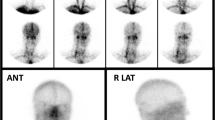Abstract
We report on the utility of technetium 99m hexamethylpropylene amine oxime (99mTc-HMPAO) to diagnose brain death following cardiac surgery on a 49-year-old man with triple-vessel coronary artery disease. The imaging parameters and criteria to diagnose irreversible brain damage (brain death) with 99m-TcHMPAO are outlined. Brain imaging with this tracer seems to be more reliable than classic radionuclide angiography and has a potential value to confirm the diagnosis of brain death at an early stage. In addition, it may be used to evaluate the perfusion pattern to other vital organs with potential for transplantation.
Similar content being viewed by others
References
Coker SB, Dillehay GL (1986) Radionuclide cerebral imaging for confirmation of brain death in children: the significance of dural sinus activity. Pediatr Neurol 2:43–46
Costa DC (1990) Single photon emission tomography (SPET) with 99Tcm-hexamethylprophyleneamineoxime (HMPAO) in research and clinical practice — a useful tool. Vascular Med Rev 1:179–201
Galaske RG, Schober O, Heyer R (1988) 99Tc-HMPAO and 123-I-amphetamine cerebral scintigraphy: a new, non-invasive method in determination of brain death in children. Eur J Nucl Med 14:446–452
Goodman JM, Heck LL, Moore BD (1985) Confirmation of brain death with portable isotope angiography: a review of 204 consecutive cases. Neurosurgery 16:492–497
Hall JW, Machey-Hargadine JR, Kimm EE (1985) Auditory brainstem response in determination of brain death. Arch Otolaryngol 111:613–620
Kohrman MH, Spivak BS (1990) Brain death in infants: sensitivity and specificity of current criteria. Pediatr Neurol 6:47–50
Pallis C (1983) ABC of brain stem death: the position in the USA and elsewhere. BMJ 286:209–210
Pjura GA, Kim EE (1987) Radionuclide evaluation of brain death. In: Freeman LM, Weissmann HS (eds) Nuclear medicine annual. Raven Press, New York, pp 168–183
Outwater KM, Rockoff MA (1984) Apnea testing to confirm brain death in children. Crit Care Med 12:357–358
Rosenklint A, Jorgensen PB (1974) Evaluation of angiographic methods in the diagnosis of brain death. Correlation with local and systemic arterial pressure and intracranial pressure. Neuroradiol 7:215–219
Schober O, Galaske R, Heyer R (1987) Determination of brain death with 123I-IMP and 99mTc-HMPAO. Neurosurg Rev 10:19–22
Author information
Authors and Affiliations
Additional information
Offprint requests to: D.C. Costa
Rights and permissions
About this article
Cite this article
Costa, D.C., Motteux, I.M.J. & McCready, A.C. Diagnosis of brain death with technetium 99m hexamethylpropylene amine oxime. Eur J Nucl Med 18, 503–506 (1991). https://doi.org/10.1007/BF00181288
Received:
Revised:
Issue Date:
DOI: https://doi.org/10.1007/BF00181288




